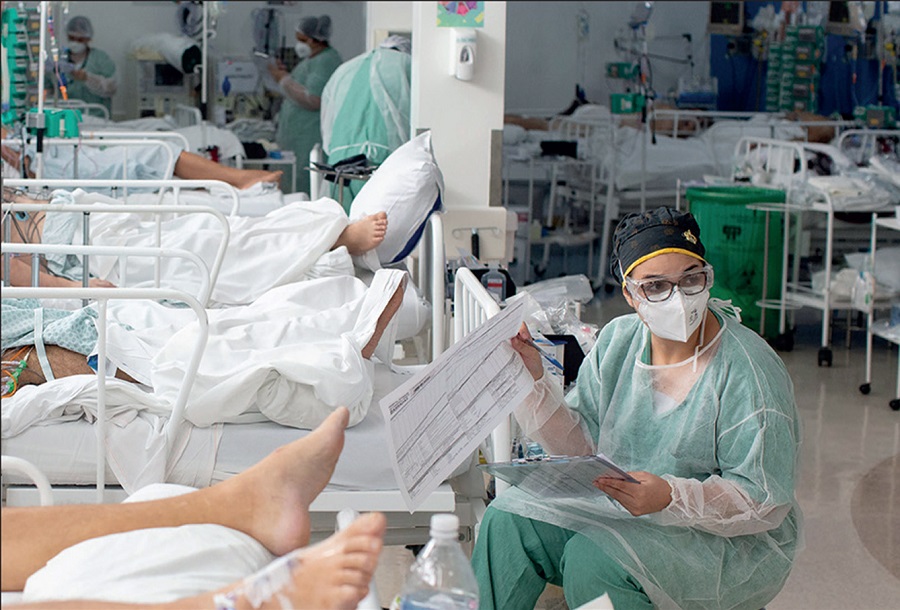RIO DE JANEIRO, BRAZIL – Still experiencing the most critical period of the pandemic, the country starts to register a reduction in the pressure on ICUs for Covid-19 treatment in large urban centers.
Fourteen state capitals (out of 26 total) and the Federal District register over 90% public ICU bed occupancy with critical patients, according to a survey by Folha de S.Paulo newspaper with data from Monday, April 19.

In all, 18 capitals registered a drop in the percentage of occupied ICU beds last week, and 5 of them are now below the critical 80% level: Salvador, Macapá, Manaus, João Pessoa and Boa Vista.
The advance in vaccination of seniors and the adoption of stricter restriction measures in recent weeks in some states are pointed out as the main factors for the drop. In Salvador, for example, the bed occupancy rate dropped from 81% last week to 76% on Monday, a drop that follows the trend registered in the state.
According to Bahia’s Health Secretary Fábio Vilas-Boas, the immunization of seniors resulted in a reduction in the number of requests for ICU beds among people over 70. “It’s a significant and sustained drop,” he says.
In the last four weeks, the number of people over 80 in ICU beds fell by 42% in the state of Bahia. Among those aged 70 to 79, the reduction was 20%.
In São Paulo, where there is also a slowdown in demand for beds, the occupancy rate reached 83% in the state, 81% in Greater São Paulo, and 84% in the state capital, says the State Health Secretariat.
President of the São Paulo Infectious Diseases Society, Carlos Magno Fortaleza highlights that São Paulo’s 2 weeks in the red phase, plus the period in which it remained in the extended red, led to a decrease in Covid-19 cases, hospitalizations, waiting lines, and ICU occupancy. “It really slowed down the pandemic. We have found that restrictive measures work, but what we have achieved so far is still very little,” he says.
At the other extreme, capitals like Campo Grande (MS) and Rio Branco (AC) have no beds available for critical patients.
In Rio Branco, intensive care beds were full on Monday. Occupancy rose to 100% in the city’s two reference units, and the transfer line, which was empty, now has 14 people.
In the capital of Mato Grosso do Sul, ICU occupancy rate reached 106%, with 37 people waiting for beds.
The scenario is also critical in other states of the Midwest. In Mato Grosso, occupancy is close to the limit, with 96% of the 608 ICU beds occupied, against 98% seven days earlier. The line was also reduced, from 85 patients to 33.
In the Federal District, there were 231 people waiting for an ICU bed on Tuesday. The Covid bed occupancy rate stood at 97%. To help overcome this problem, 3 field hospitals are being built. Each will have one hundred ICU beds.
In Goiás, the pressure on ICU beds had a slight reduction in the last week, but still, 90% of beds are occupied and there is a line. Last week there were 74 people waiting for a vacancy. Now, there are 37.
In other states, the scenario is one of stability with high occupancy rates. This is the case in Pernambuco. Despite the continuous opening of new beds, the occupancy rate remains at 97%.
In the state, there are 1,562 people hospitalized receiving intensive care. It is the highest number since the start of the pandemic. On Tuesday, there were 75 critically ill patients waiting to access a bed. For two weeks, doctors have denounced a shortage of drugs such as sedatives and neuromuscular blockers in public health units in Recife. The state government denies this.
In Rio de Janeiro state, the wait line for public ICUs dropped from 419 to 196 last week, but bed occupancy remains high, at 86%. In the city of Rio de Janeiro, the situation is stable, with 93% of intensive care beds occupied and 43 people waiting on Tuesday, April 20th.
Mayor Eduardo Paes (DEM) relaxed the restrictions last Thursday, April 15th, allowing restaurants and bars to operate in person until 9 PM and for team sports to be played on beaches and in parks. Standing or selling products on the sand, however, is still forbidden.
Paraná also remains stable, with the rate of occupancy of ICUs hovering around 94% and 148 people waiting for beds on Tuesday.
The picture is better in Rio Grande do Sul, where the ICU occupancy rate fell from 87% to 83% in one week. However, in the same period, 24 new beds were opened, and the waiting list has not lowered, remaining with 40 people. In the capital Porto Alegre, the drop in hospital capacity was even greater: from 96% to 87% after the opening of 12 new ICUs. The waiting line for beds, however, grew from 3 to 6 patients.
In Santa Catarina, the scenario is stable, with 96% of ICUs occupied despite the opening of 18 beds. More than 100 patients were still waiting for beds in the public system on Monday, April 19th.
In Minas Gerais, occupancy of public ICU beds reserved for Covid-19 registered a small drop, from 91% to 89%.
On Thursday, April 15th, the state government announced that half of the health macro-regions would move to the red wave of the flexible activities plan, a less restrictive phase than the purple wave and where adherence is at the discretion of municipalities.
“We are far from being comfortable. We still have an overloaded hospital system, health professionals are tired, and beds are few,” said Minas Gerais governor Romeu Zema (Novo).
The downward trend in the indicators in Belo Horizonte -even ICU occupancy- led mayor Alexandre Kalil (PSD) to announce the gradual opening of stores as of Thursday, April 22, after a month and a half of closures, and the resumption of in-person classes.

